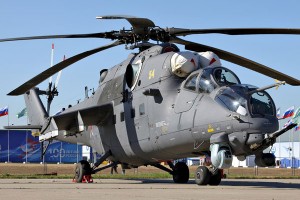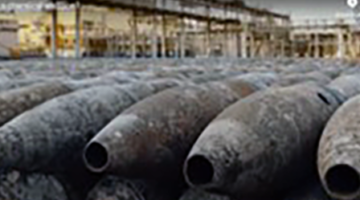Photo credit © RIA Novosti
On June 3 Moscow announced that it was lifting its earlier embargo on arms sales to Pakistan and negotiating with Islamabad to supply the Pakistanis with Mi-35 Hind attack helicopters (a helicopter already being used in Afghanistan by the US with its Afghan allies as well).
Though this announcement probably surprised many observers, in fact it comes after a long effort. For example, there are a series of articles in the Pakistani press going back to 2011-12 calling for Pakistan and Moscow to mend fences and enhance their bilateral relations, for example by negotiating an arms sales package. And there is no doubt that prior to this announcement that serious high-level discussions occurred between both governments as the arms sales are clearly not an isolated deal but part of a broader diplomatic rapprochement.
To be sure there are good reasons for Pakistan to prefer Russian weapons at this stage to its habitual reliance on Western systems.
While nobody disputes the superior quality of most US systems; they are considerably more expensive and in many cases, as India has found, Russian weapons are good enough for executing the missions necessary to operate in the South Asian theaters.
At the same time Western analysts believe that there is a possibility that Pakistan might be able to acquire better technologies than it obtains from China.
For instance, it might have a better chance to get the advanced Saturn A-31F engine for the FC-20 Fighter that it seeks form China. Indeed, Pakistan might eventually try to obtain technologies that it cannot presently obtain from China either because China cannot produce or will not export them. ( Usman Ansari, “Analysts Welcome Russian Decision on Arms Sales to Pakistan,” Defense News.com, June 4, 2014).
However, this announcement raises some important strategic and political issues for India and its relations with Russia.
India, as Simon Wezeman of SIPRI (Stockholm International Peace Research Institute) observes, is not only a major customer for Russian weapons and Moscow’s main market for arms sales but also the financier that Moscow needs to finance the development of new weapons like the new Fighter jet PAKFA. Moscow can ill afford to alienate New Delhi.
Nevertheless previous arms sales, the SU-30 Fighter, T-90 tanks, and the Gorshkov Aircraft Carrier debacle (it was to be retrofitted for India in 2008 at cost and ended up costing between $2-3 billion before it finally was sold in 2013) all revealed serious defects and mounting Indian criticism over issues of the price and quality of Russian weapons.
India has increased its engagement with Western countries and firms for its airpower requirements. It is to receive the French Rafael as its major multi mission combat aircraft, and is the largest operator of C-17s outside of the United States, are examples of this trend. Therefore Moscow may reasonably be searching to diversify its customer base for arms sales to preempt or cushion the blow of potentially fewer arms sales to India.
But beyond these considerations there are also other political and strategic factors at work or potentially at work here.
Hitherto Russia embargoed arms sales to Pakistan because it deemed Pakistan a major sponsor of terrorism in Afghanistan, India and potentially through its proxies in Central Asia. It also regarded Pakistan as the real proliferation threat.
Yet there is no public sign of what changed its mind concerning the utility of arms sales to Pakistan. Very probably this change has much to do with the impending Western withdrawal from Afghanistan, an event that fills Moscow with anxiety given its well-advertised pessimism about the future staying power of the next Afghan government.
This could lead it to seek new avenues of influence on Pakistan while simultaneously trying to exploit the visible chasm in Pakistani-US relations.
Nevertheless this sale has already incurred strong Indian complaints.
The Russian press reports that India told Russian officials once these discussions were announced that they were concerned about Moscow’s effort to exploit the interregnum between Indian governments by announcing these talks just as the new Prime Minister Narenda Mori was assuming office.
Furthermore Indian officials have dropped unofficial hints of an “us or them” choice to Moscow and told Moscow that after Deputy Prime Minister Dmitry Rogozin told the Indian media in 2012 to “spit on my face” if Russia were to arm India’s enemies.[ref] Rajiv Sharma, “India fuming over Russia lifting its Pakistan arms embargo, what next?,” Russia Today, June 6, 2014,http://rt.com/op-edge/164148-india-russia-pakistan-embargo/[/ref]
Russia will therefore have to work hard to regain India’s trust possibly by trying to expand the cope of its arms deal with India where possible.(Peter Topychkanov, “Can Russia Sell Arms to Both India and Pakistan,?” Carnegie Moscow Center, Eurasia Outlook, June 6, 2014, www.carnegie.ru/eurasiaoutlook/?fa=55823).
Pakistan’s motives in the Russian arms deal appear to be somewhat less opaque. According to Topychkanov Pakistan harbors concerns about excessive dependence on its “all-weather friend” China and wants to diversify its suppliers and obtain improved technology and offset that one-sided dependence on China.
Pakistan may clearly want to draw closer to Moscow to elicit Russian help in meeting its urgent energy problems, especially as the US-sponsored TAPI pipeline (Turkmenistan-Afghanistan-Pakistan-India) to bring Turkmen gas through Afghanistan to Pakistan and India is going nowhere and an alternative Iranian-Pakistani-India pipeline (IPI) also appears to be a distant prospect.
Finally there is a more speculative possibility that remains to be verified but bears watching.
Russia’s announcement coincides with Chinese overtures to the new Mori government. Clearly China wants to prevent India from becoming too pro-Western and to prevent an Indo-Pakistani clash or even a deterioration of relations, especially as Afghanistan’s future becomes more uncertain. Those actors also aggravate China’s already heightened concerns over Muslim terrorism, which is clearly rising in China and behind which Pakistan is to dome degree involved.
Indeed, both Moscow and Beijing have ample reason to be concerned about the trajectory of trends in Indo-Pakistani relations, Indo-Western relations, and the future of Afghanistan.
And all these issues are linked together and may become even more interlinked over time.
Meanwhile due to Ukraine and the overall estrangement of Russia from the West Russo-Chinese cooperation appears to be growing.
Is it therefore too much to suspect that we may be seeing a coordinated partnership strategy taking place here as both sides try to repair relations with the two key powers in South Asia from whom they have been estranged to facilitate further cooperation in South and Central Asia at Washington’s expense ?
The existence of such cooperation cannot be assumed in the absence of evidence, let alone be proved; yet the possibility of such cooperation must be raised, especially as we see the new energy deal and Russia’s willingness to participate in China’s Silk Road through Central Asia.
Therefore the inherently significant move by Russia to end its embargo on arms sales to Pakistan may turn out to be part of an even broader geopolitical realignment.
If for no other reason than this these impending arms sales merit our closest scrutiny.
Stephen Blank is a Senior Fellow at the American Foreign Policy Council in Washington DC. Click here for more information
The Mi-35M is primarily designed for attack and military transport missions, the helicopter delivers superior flight performance and maneuverability than its predecessor. The production of Mi-35M started in 2005. The aircraft integrates modern high-precision weaponry for destroying ground-based armoured targets and providing air support for ground missions. It can be modified as an attack, ground assault, medical evacuation (MEDEVAC) or transport platform. The Mi-35M is one of the modern combat helicopters in the Russian Air Force inventory. It is also operated by the armed forces of Venezuela, Brazil and Azerbaijan.












